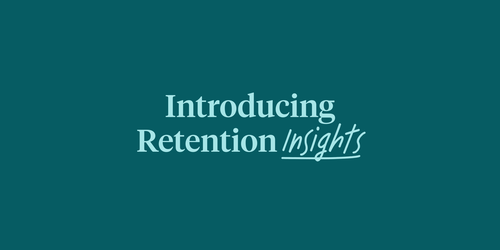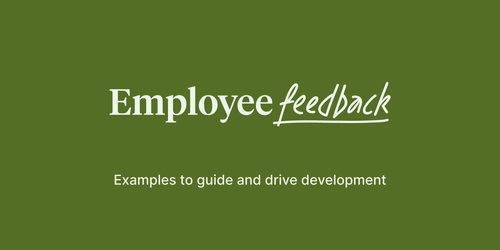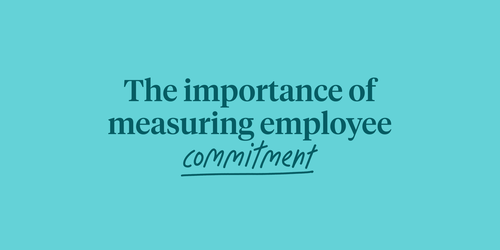
In most developed economies, unemployment is the lowest we’ve seen in the last half-century. Persistent tightness in labor markets – which has been driven by a number of factors – has created an “employee’s market” that is placing enormous pressure on companies to retain their most critical people.
Employees have more choices than ever in today’s job market, which makes it exponentially harder to keep them engaged and retained at your company. On top of that, if any of your critical people do leave, it’s much harder to replace them. As a result, employee turnover is becoming increasingly expensive and posing a growing risk to many organizations.
While it is normal for employees to come and go, there are often avoidable issues driving a high turnover rate at your company. Today, more than ever before, HR teams need an advanced understanding of the drivers of retention and turnover across all their employee groups. Without this, it is almost impossible to retain the talent your organization needs to stay competitive and successful in the future.
This guide outlines everything HR needs to know to take action on employee retention and turnover in the current conditions. Learn how to calculate your organization’s retention rate, why addressing retention is important, what the main drivers of turnover are, and how to retain employees according to our data. And learn how some of the world’s most successful companies are using tools to predict and prevent turnover across all their key groups of employees.
In this guide, we outline everything HR needs to know to take action on employee retention and turnover. Learn how to calculate your organization’s retention rate, why addressing retention is important, what the main drivers of turnover are according to our data, and how to retain employees.
What are employee retention and turnover?
Employee retention describes an organization’s ability to keep (i.e., retain) its talent. Increasing retention directly impacts a company’s business performance and success.
Meanwhile, employee turnover refers to the number of employees who leave an organization over a certain time period. Turnover falls into two main categories:
-
Voluntary turnover - When an employee leaves their organization by choice, often for a new opportunity or because of dissatisfaction with the current company. This is the type of turnover that companies usually want to address.
Voluntary turnover can sometimes be categorized as regrettable turnover if the departure has a negative impact on the team or the organization. - Involuntary turnover - When a company terminates an employee’s contract, often because of layoffs, budget cuts, or performance-related issues.
Employee retention vs. turnover
Although people tend to think of employee retention and turnover as opposites, they are not necessarily inverses of one another. Here are two key differences:
- Timeframe. Retention rate is a long-term metric that companies usually calculate annually, whereas turnover is usually calculated more frequently (i.e., monthly).
- Focus. Retention looks at how long an employee stays with the company and how to increase that number. Turnover focuses on how many people are leaving the company and why they are leaving.
Employee retention and employee turnover are interrelated concepts that give a holistic view of organizational health. Retention and turnover can each be represented using a single statistic, known as retention rate and turnover rate, respectively.
To find those rates, you need to know how to measure employee retention or turnover. Calculating retention and turnover rates can be done with simple formulas.
How to calculate employee retention rate
- First, identify the time frame you want to use. Most companies choose to measure retention using the calendar year.
- Identify the number of employees who stayed at the company for the entire time frame.
- Then, find the total number of employees who were present at the beginning of the time frame.
- Finally, divide the number of employees who stayed by the total number of employees at the beginning, and multiply that number by 100 to get the retention rate for that period.
The employee retention rate can be represented by the following formula:
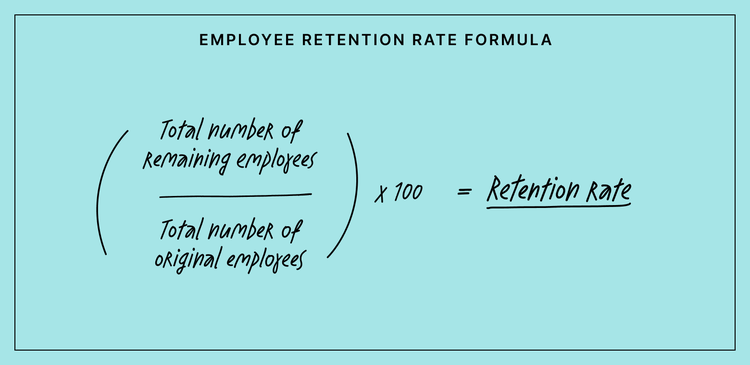
How to calculate employee turnover rate
- First, identify the time frame you want to measure. For example, you may be measuring turnover during the month of June.
- Identify the number of employees who left your company during that time.
- Then, calculate the total average number of employees at your company. This is calculated by adding the number of employees employed at the beginning of a certain period and the number of employees employed at the end of a certain period, and dividing the result by 2.
- Finally, divide the number of employees who left by the total average number of employees, and multiply that number by 100 to get your turnover rate for that period.
The employee turnover rate can be represented by the following formula:
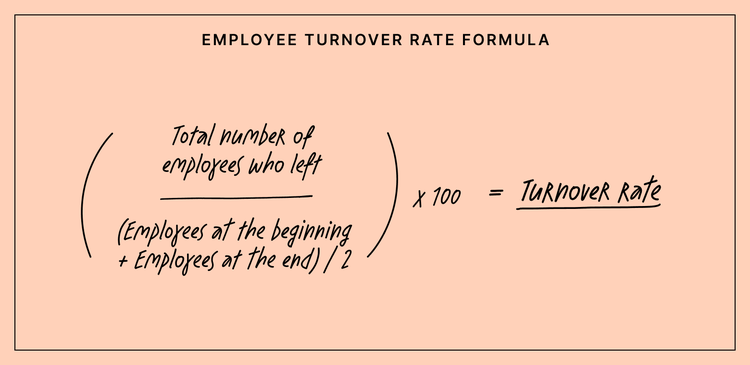
Many companies choose to calculate voluntary and involuntary turnover separately. This enables them to understand the percentage of employees who left the organization by choice vs. those who were let go or laid off.
Why employee retention is important
Employee retention is important because turnover comes with significant emotional and operational costs for the organization and the departing employee’s team. That employee’s decision to leave can negatively impact morale, leading to a loss in productivity and resources.
Some of the costs of employee turnover include:
- Loss of productivity
- Lost institutional knowledge and skills
- Increased workload and stress for remaining employees
- Time spent recruiting, onboarding, and training the new employee
- Impact on the engagement levels of other employees
- A domino effect driving additional employee turnover (also known as turnover contagion)
- Impact on the organization’s ability to achieve current goals and future goals
All in all, our research has found that replacing an employee can cost anywhere from 30% to 200% of the departing person’s salary. Gallup estimates that U.S. businesses lose up to $1 trillion annually due to voluntary turnover.
Conversely, when worker retention is high, companies experience many benefits, such as higher morale, improved perceptions of company culture, and a stronger sense of loyalty. Processes and systems are more consistent, and there’s an increased sense of connection in and across teams.

Calculate the ROI of your employee experience
Understanding employee turnover
What’s driving your employee turnover? Identifying and understanding the drivers will help you build effective strategies to reduce turnover. There’s not one simple, straightforward way to reduce turnover, because each and every company will have a unique set of factors that may be contributing to voluntary turnover. However, studies consistently show that when you improve employee engagement, you also improve retention.
For example:
- A Gallup study found that businesses with engagement scores in the bottom quartile experienced 19% more turnover in low-turnover companies and 43% more turnover in high-turnover companies than businesses in the top quartiile.
- Corporate Leadership Council found that engaged employees are 87% less likely to leave the organization.
Improving engagement to reduce turnover isn’t as simple as it might sound, because there are multiple aspects of the employee experience that influence employee engagement. However, we do know at a high level why most employees generally choose to leave their jobs.
The most common reasons why employees leave
Why do workers quit? In our research, we’ve found that the top 3 reasons people leave a company are:
-
Career growth
Employees who left expressed less agreement with the statement: “I believe there are good career opportunities for me at [Company].” This aligns with our recent research on employee development, which found that lack of employee development was the #1 reason employees leave their company.
This is supported by our research testing the myth “people don’t leave organizations – they leave managers.” We found that management does impact the level of commitment, but only if there are good development opportunities already. In companies with below-average opportunities, there is no difference in commitment between people with good managers and those with bad managers. -
Role expectations
Employees who exit the company answer less favorably when asked how strongly they agree with the statement, “I am happy with my role relative to what was described to me.” -
Inclusion
Those who left were less likely to feel like they belonged at the organization.
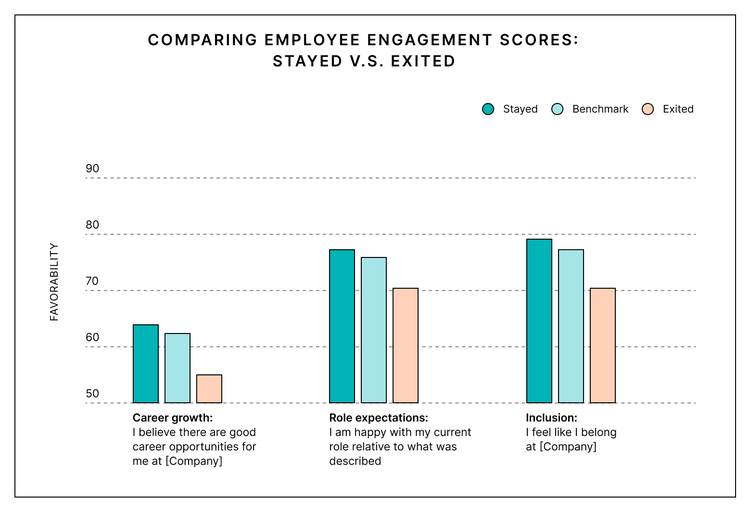
The engagement scores for employees who chose to stay were significantly higher than employees who exited the company. However, the only real way to understand why your employees are leaving your organization is to ask them.

Learn how turnover and hiring affect the employee experience
We looked at data from over 1.8 million employees to learn how hiring and retention affect the employee experience – and your company’s ability to overcome uncertainty.
Want to predict turnover? Just ask your employees
In our research, we found that the best way to predict who will leave your company is to ask them directly. Of all the employee survey questions we looked at, the most predictive by far was our future commitment item – “I see myself still working at [Company] in two years’ time.”
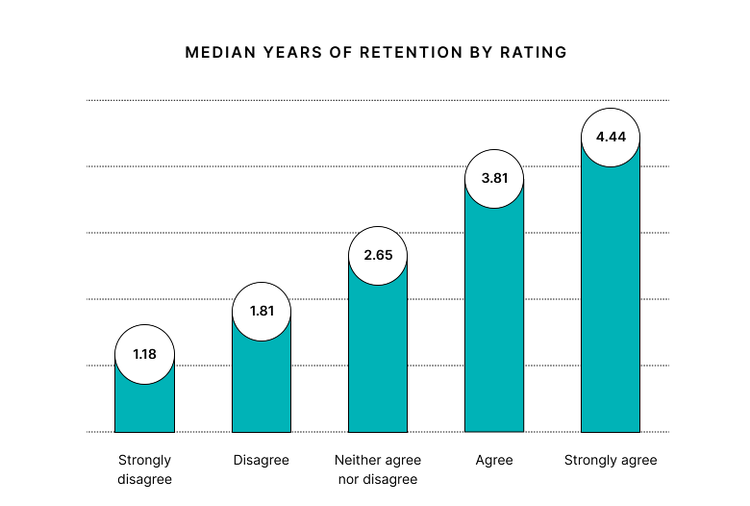
We found that the median amount of time employees stayed with an organization after selecting “strongly disagree” was a mere 1.18 years. Conversely, those who selected “strongly agree” stayed with their organizations for a median of 4.44 years.
The specific median periods in which employees stayed with their company after answering the commitment question were:
- 1.18 years from the first time an employee answered “strongly disagree”
- 1.81 years for “disagree”
- 2.65 years for “neither agree nor disagree”
- 3.81 years for “agree”
- 4.44 years for “strongly agree”
This result is consistent with our 2020 and 2017 findings.
Furthermore, employees will also tell you why they leave. When asked for their reason for leaving in an exit survey, we found that the top reason they chose to exit was highlighted in their engagement survey responses months before.
For example, we found that employees who selected “manager” as their main reason for exiting scored below the bottom 5th percentile on the Management factor in the engagement survey – which is a startling 29% points below employees who did not select their manager as a reason for leaving.
How to improve employee retention
The best way to improve employee retention is to understand the main drivers of turnover at your specific company. To do this, you need to, first and foremost, collect feedback from your employees.
As explored in our research, you can be confident that when you collect feedback, your employees will tell you:
- If they’re planning to leave
- Why they’re thinking about leaving
Moreover, we’ve found that even the most basic efforts to engage employees can help reduce turnover. Companies that seek regular employee feedback have been found to have turnover rates that are 14.9% lower than those that don’t.
There are two main vehicles for gathering insights into turnover and retention:
-
Engagement surveys
If you ask the right questions, engagement surveys help reveal whether a given employee is likely to depart (“I see myself still working at [Company] in two years’ time”) – and the reason for their exit. To identify the latter, you can look into where that employee is scoring below the benchmark. -
Exit surveys
Holding an exit survey will give you the opportunity to understand why a certain employee is leaving and whether their exit was preventable.
These surveys can also be leveraged at the team, departmental, or organizational level to explore whether there are patterns or trends to turnover at your company. For example, you may realize that L&D is a huge opportunity for improving retention at your company if you notice that many departing employees select “lack of learning and development opportunities” as a reason for leaving in their exit survey.
We also recommend including a performance rating as a filter in your engagement survey results to see how your high-performing employees’ experiences may differ from those of other employees at your company. After all – those are the people you most want to engage and retain.
6 effective employee retention strategies
There are countless ways to take action on turnover. After all, the most impactful action will depend on your organization’s specific culture. However, there are some high-level strategies we find relatively effective for organizations of all sizes and industries.
Here are six employee retention ideas for reducing turnover at your company.
-
Get ahead of potential turnover by focusing on the most predictive questions
Be sure to ask employees how strongly they agree with the statement, “I see myself still working at [Company] in two years’ time,” as our research has shown that people are typically honest when answering this question. It’s also worth asking questions focusing on learning & development, role expectations, and inclusion, as these are the three top reasons most employees decide to leave their companies. -
Prioritize learning and development
As we’ve mentioned, a lack of employee development opportunities is the #1 reason an employee chooses to leave the company. Creating a strategic and personalized development plan can put your organization in the driver's seat when it comes to increasing employee engagement and retaining your top talent. Ensure that L&D is a priority for leaders at your organization, clearly outline roles and responsibilities, and measure employee development so that you can effectively scale and optimize your retention strategy. -
Get ahead of burnout
Employee wellbeing directly affects engagement at a company, which means it’s important to avoid burnout by making wellbeing a priority.
In our study looking at burnout, we compared survey responses to the statement “I rarely feel overstressed by my work” with engagement scores. We found that people who responded favorably were, on average, 89.5% engaged. Meanwhile, those who strongly disagree (i.e., are very stressed) were only 39.7% engaged. We also found that people who are feeling stressed are more likely to leave their organization within the next 12 months.
We recommend providing resources that align with employee needs, demonstrating support from the top, and helping employees set healthy boundaries (e.g., not answering emails after work hours, empowering them to say “no” when workloads are heavy). -
Recognize your employees
People want to feel valued and appreciated for their efforts, which is why employee recognition is a crucial aspect of employee engagement. Otherwise, what’s the point of working hard? Employees who feel like they’re being taken advantage of will likely leave, so providing regular and timely gestures of recognition is critical. Of course, the most fulfilling form of recognition is usually a promotion or salary increase, but employees will appreciate other types of informal recognition (i.e., handwritten notes, kudos at an all-hands meeting, gift cards, etc.). -
Train empathetic managers
Managers who lead with empathy are more in tune with how their direct reports feel, meaning they’re also better equipped to respond to their teams’ needs. In that way, empathetic managers can make a huge difference in helping organizations retain talent.
However, empathy isn’t a natural or easy skill for every manager. You can help managers develop this critical skill by teaching them to use interchangeable responses to confirm their understanding of a situation. You can also leverage tools like Skills Coach, which uses the magic of spaced repetition, to help people develop the critical skills they need to succeed in today’s world of work. -
Conduct stay interviews
If turnover is something your organization is concerned about, ask managers or skip-level managers to conduct “stay interviews” with their direct reports. These conversations address what an individual loves about working at your organization and what your company needs to change to keep that employee engaged and retained. Stay interviews also help your managers better understand their employees’ mindset, career goals – and, of course, the likelihood of them leaving the company in the future.
While most stay interview findings will directly impact the interviewed employees’ experience at work, some discussion topics can help you improve the employee experience for all your workers. For example, you may realize you need to increase headcount to improve work-life balance in your team. This makes stay interviews an excellent opportunity for not only retaining your top talent by identifying their individual wants and needs but improving retention as a whole via broader team or organizational changes.
How Culture Amp supercharges the employee experience
Reducing high turnover requires improving the overall employee experience. Doing so strategically requires a knowledge of which groups are most at risk at your company, and how critical they are to your company.
While it’s important and useful to know what some of the more common drivers of turnover are, it’s important to keep in mind that not all organizations are alike. Your organization is unique and will have its own unique drivers of both retention and turnover. It’s also likely that your drivers of retention and turnover will vary by department, function, level, tenure, gender, etc. The employee experience at organizations is not consistent, so it’s critical for you to understand these differences at the group level.
That’s where Culture Amp’s all-in-one employee experience platform comes in. With our latest tool, Retention Insights, you can stop turnover before it’s too late. By automatically connecting your HRIS and survey data, this one-of-a-kind retention solution will detect the earliest turnover warning signals across all groups and empower you to:
- Prevent future turnover - By understanding exactly what's driving retention and turnover at the group level, you can implement targeted strategies to reduce future turnover.
- Prove the value of your engagement program - By helping leaders and managers understand the link between engagement and retention in their area – you can elevate your survey initiatives as a business-critical priority across the company.
- Retain critical people - By understanding what motivates key groups (such as top performers or critical leaders) to stay with or leave each area of your business, you can take targeted actions to keep your most valued people.
By combining employee and turnover data with data around intent to stay or leave, Retention Insights empowers you and other leaders across your business with a comprehensive, people-science-informed framework for accurately predicting and preventing future turnover – all through one easy-to-use dashboard that surfaces comprehensive answers to your previously unanswerable turnover questions.


